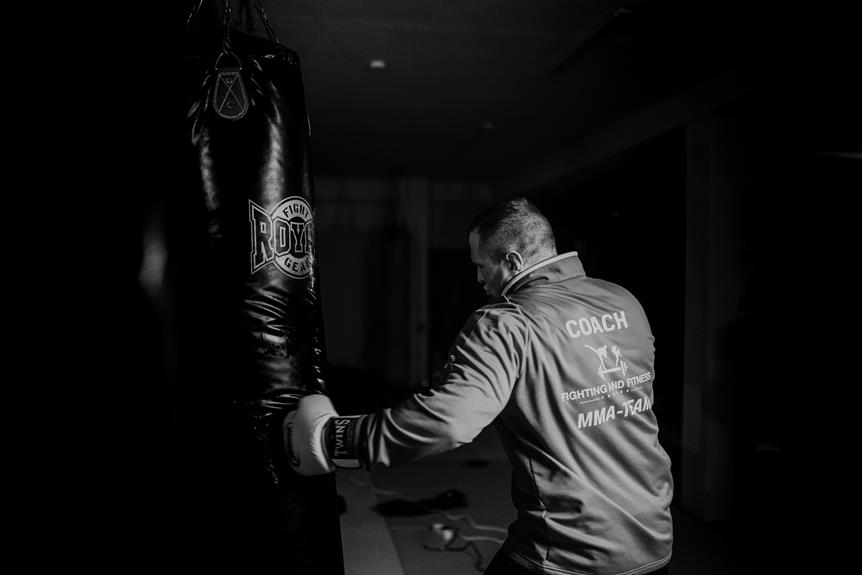Rabbit punches, a term frequently heard in the world of boxing and MMA, have been a cause for concern among combat sports enthusiasts.
These illegal strikes, targeting the back of the head or neck, can have devastating consequences. In fact, the impact from a rabbit punch can disconnect the brain from the brain stem, resulting in paralysis or even death.
This article aims to delve into the reasons behind the prohibition of rabbit punches, the penalties involved, and the documented cases of injuries and fatalities associated with this dangerous technique.
Key Takeaways
- A rabbit punch is a punch landing on the back of the head or back of the neck, and it is illegal in boxing, MMA, and all striking sports.
- Rabbit punches can cause death by disconnecting the brain from the brain stem, as well as brain damage and paralysis by damaging the cervical vertebrae and spinal cord.
- The term 'rabbit punch' comes from the technique used by rabbit hunters to stun or end a rabbit's life, which involves striking the back of the rabbit's head.
- Rabbit punches are prohibited in combat sports due to the severe potential consequences they pose, including paralysis, brain damage, and death.
Definition of a Rabbit Punch in Boxing/MMA
A rabbit punch in boxing and MMA refers to a strike directed at the back of the head or neck, which is considered illegal due to its potential for causing severe injuries and even death. Rabbit punches can be devastating, as they can disconnect the brain from the brain stem, leading to paralysis or even instant death. These strikes can also cause brain damage and damage to the cervical vertebrae and spinal cord.
Rabbit punches are often unintentional, occurring during clinches, head movement, or off-target punches. To prevent rabbit punches in combat sports, fighters should focus on maintaining proper technique, targeting legal areas, and practicing control and accuracy in strikes. Coaches and officials should also enforce the rules and penalize fighters who engage in rabbit punching.
Dangers and Consequences of Rabbit Punches
Numerous dangers and severe consequences are associated with rabbit punches in combat sports such as boxing and MMA. The prevention of rabbit punches and the importance of referee intervention play a crucial role in ensuring the safety of athletes. Here are four key points to consider:
- Prevention of rabbit punches: Coaches and trainers must educate fighters about the dangers of rabbit punches and emphasize proper striking techniques that avoid targeting the back of the head or neck. Promoting good sportsmanship and respect for the rules can also help prevent intentional rabbit punches.
- Importance of referee intervention: Referees have a vital role in protecting fighters by enforcing the rules and penalizing any illegal strikes, including rabbit punches. Their intervention is crucial in maintaining a fair and safe environment inside the ring or cage.
- Safety measures: Combat sports organizations should continually review and update their safety protocols to minimize the risk of rabbit punches. This can include mandatory training for referees, stricter penalties for fouls, and regular medical check-ups for fighters.
- Education and awareness: Raising awareness among fighters, coaches, and fans about the dangers and consequences of rabbit punches is essential. By promoting knowledge and understanding, the combat sports community can work together to prevent these dangerous strikes and prioritize the well-being of athletes.
Origin and Significance of the Term 'Rabbit Punch
Derived from the technique used by rabbit hunters to stun or end a rabbit's life, the term 'rabbit punch' in combat sports refers to striking the back of the head with similarities to the hunters' method. Rabbiters employ a karate-style chop, club, or stick to strike the back of a rabbit's head, aiming to deliver a quick and effective blow. This striking technique has been adapted and incorporated into combat sports, where fighters target the vulnerable area at the base of the skull. The evolution of combat sports terminology has led to the adoption of the term 'rabbit punch' to describe this specific strike. The term carries with it the weight of the potential danger and consequences associated with such a blow, emphasizing the importance of its prohibition in boxing, MMA, and all striking sports.
| Rabbit Punch Techniques | Evolution of Combat Sports Terminology |
|---|---|
| Strike to the back of the head | Incorporation of hunting technique into combat sports |
| Similarities to rabbit hunting | Adaptation and adoption of the term 'rabbit punch' |
| Focus on vulnerable area at the base of the skull | Recognition of the potential danger and consequences |
| Prohibition in boxing, MMA, and all striking sports | Evolution of combat sports terminology to encompass the specific strike |
Reasons for the Illegal Status of Rabbit Punches
Multiple factors contribute to the illegal status of rabbit punches in boxing and MMA. These factors include:
- Cervical vertebrae damage: Rabbit punches, which land on the back of the head or neck, can cause severe damage to the cervical vertebrae. The force of the punch can lead to spinal cord injury, potentially resulting in paralysis.
- Potential brain stem detachment: The brain stem, located at the back of the skull, is responsible for vital functions such as breathing and heart rate regulation. Rabbit punches have the potential to detach the brain stem from the brain, causing instant death.
- Grave consequences: Rabbit punches can lead to brain damage, paralysis, and even death. Due to the critical nature of these injuries, combat sports organizations have deemed rabbit punches illegal to protect the safety and well-being of the athletes.
- Prohibition in combat sports: Recognizing the potential dangers associated with rabbit punches, boxing, MMA, and all sports-based martial arts have strictly prohibited this technique. The aim is to prevent catastrophic injuries and ensure the long-term health of fighters.
Penalties for Rabbit Punching in Boxing and MMA
Penalties for rabbit punching in boxing and MMA vary depending on whether the foul is intentional or unintentional.
Intentional rabbit punches, although rare, can result in severe penalties if they cause injury. In boxing, the fouling boxer may be deducted 2 points, while in MMA, intentional illegal strikes lead to a deduction of 1 point. If an intentional rabbit punch renders the opponent unable to continue, the fouling fighter is disqualified.
On the other hand, unintentional rabbit punches are more common, and the outcome can be a no-decision or no-contest depending on the timing of the fight's end.
To prevent rabbit punches in combat sports, fighters are trained to aim for legal targets and avoid striking the back of the head or neck. Referees play a crucial role in enforcing the rules and penalizing fighters who commit rabbit punches, ensuring the safety of the athletes.
Cases of Rabbit Punch Deaths and Injuries
Several high-profile incidents of rabbit punch deaths and injuries have occurred in both boxing and MMA. These cases shed light on the prevalence of unintentional rabbit punches and the long-term effects they can have on athletes. Here are some noteworthy examples:
- Raul Hirales vs Francisco Leal (2013): Leal suffered a fatal brain injury after being struck with a rabbit punch during their fight.
- Tim Hague vs Adam Braidwood (2017): Hague tragically passed away due to brain damage caused by a rabbit punch in the ring.
- Terrell Williams vs Prichard Colon (2015): Colon was left in a vegetative state after a series of rabbit punches led to a severe brain injury.
Numerous other incidents of rabbit punches have resulted in concussions, spinal injuries, and lasting neurological damage.
These cases emphasize the need for strict enforcement of rules against rabbit punches in combat sports to protect the health and safety of athletes.
Conclusion
In conclusion, the practice of rabbit punching in boxing and MMA poses significant dangers and consequences. The impact of a rabbit punch can result in severe injuries such as paralysis, brain damage, and even death. Due to these potential risks, rabbit punches are considered illegal in all striking sports.
The penalties associated with such fouls aim to deter fighters from using this dangerous technique. It is crucial for combat sports organizations to strictly enforce the rules and regulations to ensure the safety and well-being of the athletes.
Like a predator stalking its prey, the rabbit punch lurks as a lurking danger in the world of combat sports.
- 15 Best Martial Arts Weapons (Fighting & Training) - October 14, 2024
- Is Fencing a Martial Art? (Yes, 4 Reasons Why) - October 14, 2024
- 7 Best Martial Arts for Self-defense Ranked (Highly Effective) - October 14, 2024










